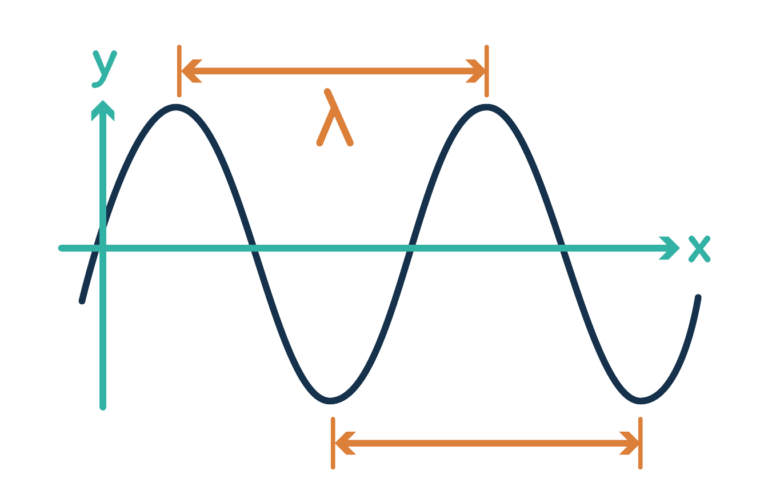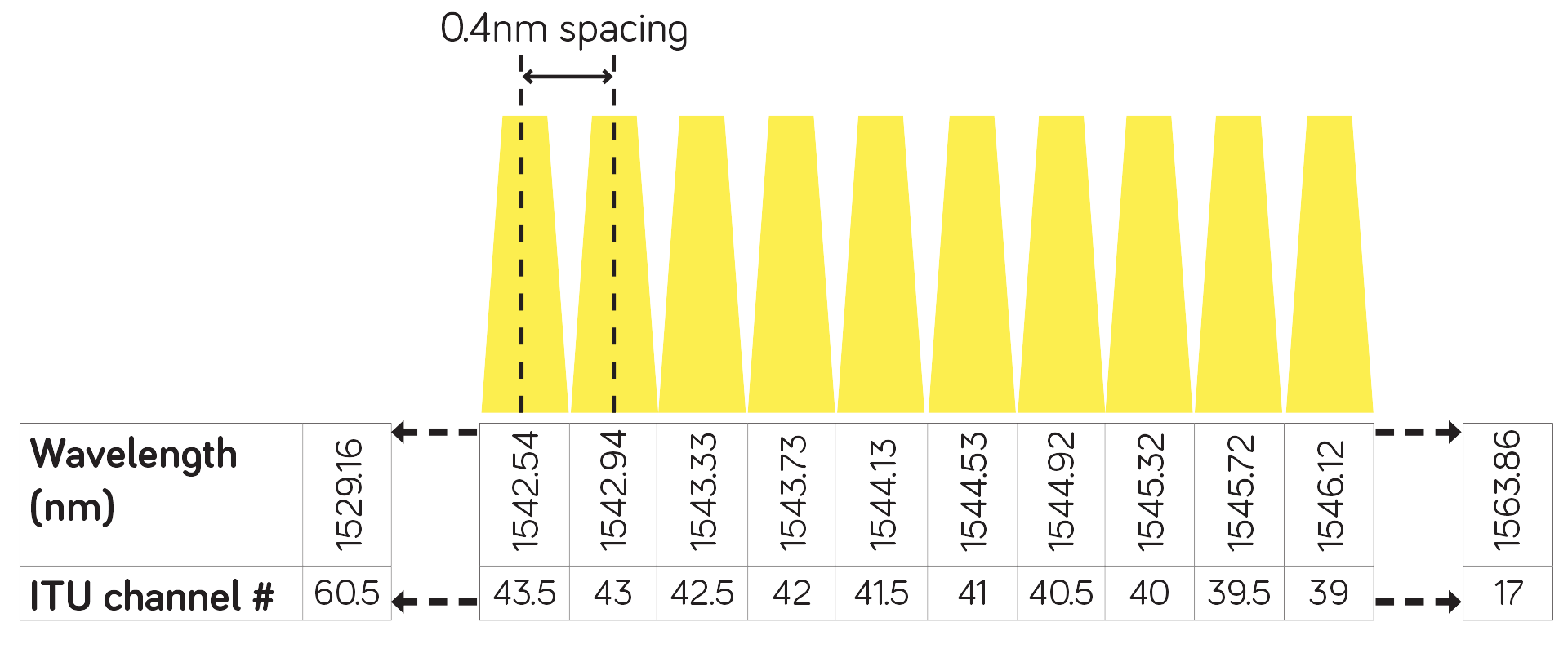Optical wavelengths refer to the light channels that transmit data in fibre optic networks. Learn all about optical wavelengths, their different types, and how leasing wavelengths can supercharge your business network.
- What is a wavelength?
- What are optical wavelengths?
- Main types of optical wavelengths
- What are nominal wavelengths?
- What are long-haul wavelengths?
- What are the benefits of optical wavelengths?
- Optical wavelengths for your business
What is a wavelength?
In physics, a wavelength is the distance between the corresponding points of a wave. For example, the wavelength of the wave below is the distance between its peaks and troughs.
λ = wavelength

What are optical wavelengths?
In fibre optic networks, optical wavelengths refer to the different channels of light used to transmit data. It’s the distance between the peaks or troughs of the light waves used for each channel and is typically measured in nanometres (nm) or billionths of a metre.
The light signal is divided into multiple channels with different frequencies and wavelengths, each transmitting a different data stream. This way, you can transmit up to 88 or more data streams on a single fibre optic cable.
Main types of optical wavelengths
In fibre optic networks, wavelengths are classified by how they divide the light. Optical networks use a technology called Wavelength Division Multiplexing (WDM) to create multiple channels on a single fibre. There are two main types of WDM: CWDM and DWDM.
CWDM
Coarse Wavelength Division Multiplexing (CWDM) typically uses eight active wavelengths per fibre but can support up to 18 channels or more. It’s generally used for short-range networks and can be more cost-effective than DWDM.
DWDM
Dense Wavelength Division Multiplexing (DWDM) uses precision lasers to create up to 88 channels or more per fibre. Typically used in core networks or other high capacity applications, DWDM is a good option for businesses transmitting large data volumes over longer distances.
DWDM optical wavelengths

The table above shows the nominal wavelengths of a typical 88-channel DWDM system.
What are nominal wavelengths?
Nominal wavelengths refer to the centre wavelength of each data channel, as set by the International Telecommunications Union (ITU).
For example, in the DWDM optical wavelengths table above, channel 43.5 has a nominal wavelength of 1542.54nm, which is spaced 0.4nm from channel 43 (1542.94). By standardising nominal wavelengths, the ITU ensures that optical network components are compatible and interoperable worldwide.
What are long-haul wavelengths?
Long-haul wavelengths are the light wavelengths used to transmit over long-distance optical networks. Typically, fibre networks use DWDM wavelengths on the C-band (around 1530-1565nm), and some operators use the L-band (around 1565-1625nm) to maximise capacity on their optical systems.
DWDM supports a higher number of channels and higher data rates than CWDM, providing ample capacity for long-haul optical networks.
In addition, DWDM allows you to amplify the signal using devices like erbium-doped fibre amplifiers (EDFA), massively extending its range. While CWDM is suitable for distances up to 80km (50 miles), DWDM can support networks over hundreds or thousands of kilometres using amplification techniques.
What are the benefits of optical wavelengths?
Optical wavelengths provide high capacity connectivity that’s ideal for communication service providers, data centres, financial services, media and other enterprises transmitting high data volumes.
DWDM-enabled optical networks can provide:
- High capacity: Diverse wavelengths make the most of existing fibre networks, providing more channels, greater bandwidth and speeds up to 400Gbps carried over wavelengths with a potential capacity of 1.6Tbps in the latest vendor technologies.
- Low latency: Optical networks typically have much lower latency than other types of L2 services.
- Easy scalability: Add new channels by simply adding new wavelengths, allowing upgrades without significantly changing the network architecture
- Security: Optical networks can support encryption and ‘dedicated’ wavelengths, which provide exclusive channels for your business to run mission-critical applications.
By leasing optical wavelengths, you only pay for the capacity you need now and scale as you grow. You avoid the upfront costs of building infrastructure and hiring personnel to manage your network.
Optical wavelengths for your business
At Neos Networks, we’re helping businesses nationwide transform their networks with Optical Wavelengths delivering speeds up to 400Gbps.
If you’re looking to upgrade your network to meet the exploding demand for bandwidth, get in touch. We’ll be happy to design a cost-effective optical wavelength solution for your digital future.
Optical wavelengths FAQs
-
How do optical wavelengths enhance the efficiency of fibre optic networks?
Optical wavelengths significantly boost the overall capacity of a network by allowing the simultaneous transmission of multiple signals on a single fibre, boosting maximum data transmission speeds and bandwidth.
-
What is the role of Wavelength Division Multiplexing in optical networks?
Wavelength Division Multiplexing (WDM) is a vital technology used to increase the bandwidth of fibre optic networks by splitting the light signal into multiple channels on a single fibre. There are two main types of WDM: Coarse Wavelength Division Multiplexing (CWDM) and Dense Wavelength Division Multiplexing (DWDM).
-
How does DWDM compare to Dark Fibre?
A Dark Fibre network consists of ‘unlit’ fibre optic cables with no service or traffic running on them. You deploy and manage the equipment needed to light it. DWDM is a technology you can deploy to maximise your network’s capacity.
However, deploying and maintaining your own DWDM service requires significant resources and expertise, so leasing optical wavelengths is often a better solution. Learn more about Dark Fibre vs DWDM.
-
How does Dark Fibre differ from Lit Fibre?
Dark Fibre is a fibre optic cable that’s not connected to any equipment or transmitting any data. You lease or buy this fibre from a network provider and then deploy the equipment and maintain the network yourself.
In contrast, Lit Fibre refers to fibre optic cable carrying a managed service like Optical Wavelengths or Ethernet, with the network provider responsible for maintaining the service. Learn more about Dark Fibre vs Lit Fibre.
-
What are ROADMs?
A reconfigurable optical add-drop multiplexer (ROADM) is a piece of hardware that has access to all wavelengths on a fibre line in multiple directions. It enables you to remotely provision traffic from a Wavelength Division Multiplexer (WDM) without redesigning the network. So you don’t need to assign how the entire bandwidth will function at the deployment stage. You can configure and change it as required.





